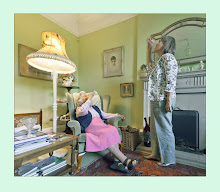George Bernard Shaw, who frequently posed for his own pictures, often experimented with lighting and early colour printing. Photograph: LSE/National Trust
George Bernard Shaw will be exposed, stripped bare as never before, when the contents of cupboards and drawers, albums and boxes crammed into his last home go on display for the first time – the thousands of photographs that were the Nobel laureate's other great passion in life.
An exhibition of original prints will open at the National Trust's Fox Talbot Museum in Lacock, Wiltshire, on Thursday, while the guardian of Shaw's photographic archive, the London School of Economics, has mounted anonline exhibition as well. Both have astonishing images, including several of Shaw naked, apart from his whiskers.
From 10,000 images, mostly printed by Shaw, Roger Watson, curator of the Lacock exhibition, has chosen a startling self-portrait of the playwright lying on a sofa, lit by a single overhead lamp, naked apart from a strategically placed book. Shaw's long, skinny body could be a medieval tomb carving, apart from the hints in the shadows of a 20th-century background.
"It really is a very striking and unusual image," Watson said. "A more conventional photographer would have cropped the lamp out of the print, but to me that makes the picture. "
Karyn Stuckey, the curator at the LSE who has been cataloguing the vast collection and created the online exhibition, was taken aback when she discovered the image of a naked Shaw bending over to set his camera, reflected in a mirror. "I was ploughing through hundreds of slightly dull prints, and expecting something entirely different to come up next, and I suddenly went 'Whoa, what's that?'"
Shaw, who took up photography in 1898, frequently photographed himself nude, and also posed on a beach as Rodin's Thinker for the actor Harley Granville Barker, but admitted "I merely looked constipated".
Both exhibitions are full of biographical hints for the curious. There are relatively few photographs of men, but many of beautiful and sensuously photographed – if fully clothed – women friends. They include the actor Lillah McCarthy and the even more ravishing Beatrice Webb, co-founder of the LSE with the Shaws and her husband and fellow Fabian, Sidney Webb. His most famous leading lady, Mrs Patrick Campbell, was captured lying in bed. He wrote to her: "I want the lighter of my seven lamps of beauty, honour, laughter, music, love, life and immortality", but the relationship smouldered almost entirely on paper.
There are many photographs of his wife, Charlotte. Long before his writing made him rich, Shaw's money problems were solved by marrying the Irish heiress in 1898. One frank portrait shows her looking trustingly straight to camera: on the back he captioned it "nee Charlotte Payne-Townshend Mrs Bernard Shaw" – then crossed that out and wrote "The green-eyed millionairess".
By the time Shaw died at Ayot St Lawrence in Hertfordshire in 1950, aged 94 – after falling out of an apple tree he was trying to prune – he had accumulated 10,000 prints and more than 10,000 negatives.
The house and contents were left to the National Trust. In 1979 the photographs, still uncatalogued and many on mouldering and potentially dangerous old film, were transferred to the archives of the London School of Economics for safe storage. In a marathon joint LSE and National Trust project all have been conserved, digitised – almost crashing the LSE website – and catalogued over the past two years.
Shaw was typically writing thundering reviews of photographic exhibitions long before he started photograpy. Stuckey and Watson agree that the best were taken with Shaw's earliest cameras, when he was experimenting with lighting and early colour printing, and creating strikingly composed shots that demanded careful planning and minutes of immobility from his subjects, rather than the snapshots he produced when he bought a Leica and began using 35mm film in the 1930s.
A handful of his photographs were reproduced or exhibited in his lifetime, but thousands had never been seen by anyone since Shaw last looked at them.
"He's not perhaps a first-rank photographer, but he's very high in the second rank, at least in his early days," Watson said. "If somebody brought these in and said they were their grandfather's and asked if we would exhibit them, the truthful answer would probably be no. I'd say they'd be lovely to have, lovely to go through the albums, but I'm not sure how many outsiders would come to see them. But as the work of Shaw, they're a different story entirely. I think people will be fascinated."
George Bernard Shaw: Man & Cameraman, will be showing at the Fox Talbot museum, Lacock Abbey, Wiltshire, from 7 July to 11 December 2011

No comments:
Post a Comment